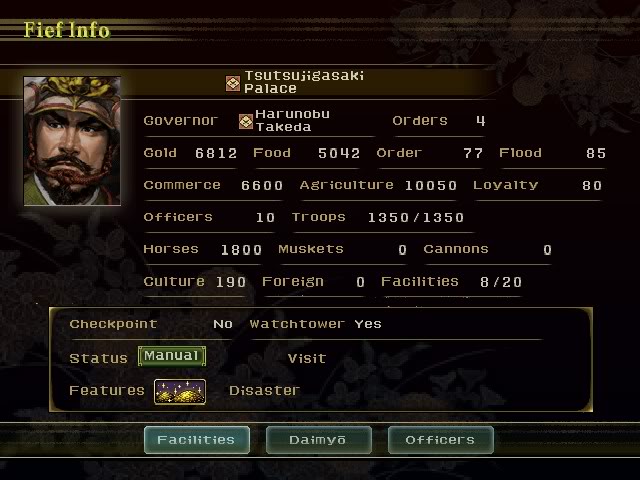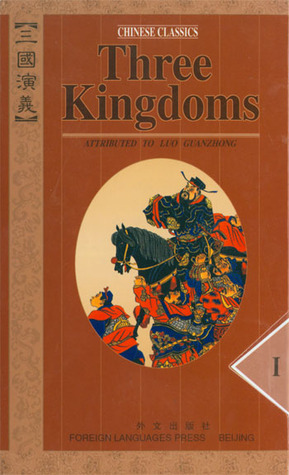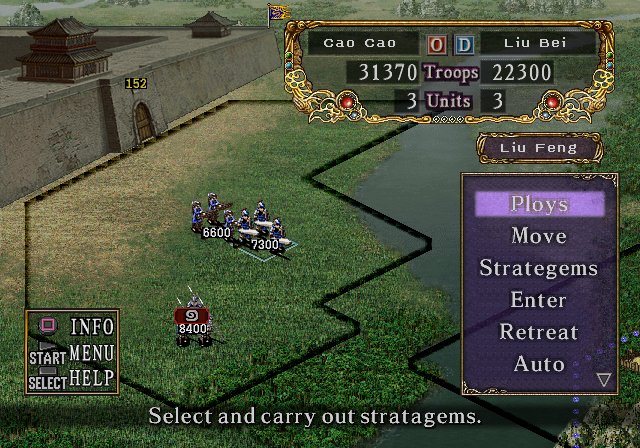Last updated on July 30, 2013
- Part 1 – Nobunaga’s Ambition and a Short History of Koei
- Part 2 – You Can’t Know Everything
- Part 3 – Playing Nice With Others
For whatever reason, Nobunaga’s Ambition received exactly three releases in the West before disappearing entirely from Koei’s localization roundup. The first game, obviously, found ports to every system and computer under the sun, as did the second game. The third game, Lord of Darkness, remains a personal favorite of mine due to its relative simplicity. I’m not sure why that game in particular makes constant warfare without development such an easy task, but who am I to complain? I’ve played that game in multiplayer several times (over a summer vacation or two, as you might guess) and it’s still fun now with its simplistic rock-paper-scisssors combat (calvary beat infantry, guns beat cavalry, infantry beats guns) and great music. Somehow, it never became boring after hundreds of hours, and even when the save battery died I bought a new cartridge off eBay.
So why am I not talking about Nobunaga’s Ambition: Lord of Darkness, then? While it’s a personal favorite, the above should tell you that it lacks a bit of the complexity that even the earlier releases had. Yes, they added tea ceremonies, technology, and culture, but you could completely ignore that if you captured fiefs with high tech ratings already, thus rendering personal development as such moot. Officers could turn on you (and assassinate you) on the whim of a hat, and there’s lots of strange mysterious hidden numbers making things more difficult (the loyalty thing is a big problem, let me assure you). While it’s a favorite, I’d be remiss in recommending it rather than Koei’s other flagship series. They released two other Nobunaga’s Ambition games in the United States, and both Rise to Power and Iron Triangle have their own idiosyncrasies.

By contrast, Romance of the Three Kingdoms iterates, while Nobunaga’s Ambition continues to innovate and alienate its audience alike. Rise to Power contains a real-time strategy style for battles that doesn’t work out that well on a PS2 controller, whereas Iron Triangle goes the “everything on the same map” route, making the game incredibly complex and daunting to even the most dedicated fan of the genre. Koei, apparently, thought we needed to wait fourteen years before seeing another Nobunaga’s Ambition game, and I think they may have been right. Romance of the Three Kingdoms provided a system based on the earlier games with intuitive improvements. As you can see, the transition to a new system generation (even between Romance of the Three Kingdoms VI to VII) improved the game a great deal.
Partly due to this consistency and relative ease of use, it’s no wonder that Western gamers who loved Koei games had to settle for Romance of the Three Kingdoms after a while. The only two games in the series that gamers this side of the pond missed were V (which I hear is rather horrible) and the most recent one, XII (which I also hear is rather horrible), so thank goodness we did not need to engage in that fun. They tend to localize the best entries, and as far as Romance of the Three Kingdoms is concerned, that would apparently be most of them.
Technically, the series isn’t based around direct historical events; rather, it works from the famous novel Three Kingdoms (called “Romance” by most English audiences until recently, as the original title, usually romanized Sanguoshi, literally means Three Kingdoms). This story, told many times and adapted into novel form by Luo Guanzhong, tells the story of the fall of the Han dynasty following the Yellow Turban/Scarves rebellion, the split of the empire into three kingdoms, and the eventual unification of those kingdoms under a single banner. While it’s a book about the events that occurred (with magic and sages to fill in the rest, probably not historical), it’s also an incredibly long tale about the passage of time, ambition, and the insignifcance of your personal cause in the grand scheme. As the book begins and ends:
The world under heaven, after a long period of division, tends to unite; after a long period of union, tends to divide. This has been so since antiquity.
Whatever way it is rendered, that is a very Confucian way of looking at the world. Things come full circle, and regardless of the author’s personal bias towards one Kingdom of the three (if you couldn’t tell, it’s Shu and Liu Bei along with Zhuge Liang, or Kongming), things tend to come back together. Even the greatest heroes fall and die of old age. More often than not, the extreme length of the book in English at over 2200 pages, and characters with distinctly non-English names, it’s hard to get that sense without Chinese/Asian cultural knowledge. However, it does give you perspective – specifically, all the things you DON’T know about the world.
In fact, the density of the knowledge here shows us a bit of our own insignificance in the grand scheme. Think of it this way: Koei historical simulations condense an entire period of history into a game, and it’s still humongous and incomplete. When Ecclesiastes 3:20 (and Genesis 3:19) tells us that from dust we were created and to dust we shall return, it’s not joking. World history might remember you, but you are only remembered by human beings. Further, in Ecclesiastes 12, we see this:
Remember also your Creator in the days of your youth, before the evil days come and the years draw near when you will say, “I have no delight in them”; 2 before the sun and the light, the moon and the stars are darkened, and clouds return after the rain; 3 in the day that the watchmen of the house tremble, and mighty men stoop, the grinding ones stand idle because they are few, and those who look through windows grow dim; 4 and the doors on the street are shut as the sound of the grinding mill is low, and one will arise at the sound of the bird, and all the daughters of song will sing softly. 5 Furthermore, men are afraid of a high place and of terrors on the road; the almond tree blossoms, the grasshopper drags himself along, and the caperberry is ineffective. For man goes to his eternal home while mourners go about in the street. 6 Remember Him before the silver cord is broken and the golden bowl is crushed, the pitcher by the well is shattered and the wheel at the cistern is crushed; 7 then the dust will return to the earth as it was, and the spirit will return to God who gave it. 8 “Vanity of vanities,” says the Preacher, “all is vanity!”
To put things in perspective makes life a bit less serious and a lot more enjoyable, I have to say. It’s nice to put the narcissist within in his place and understand your place in the world is exactly the task God gave you, and nothing else. That’s why there’s a Church, after all, and why one human being alone cannot contain God’s image.
Regardless, thanks to Koei, I found myself intimately familiar with the subject matter, and thoroughly enjoyed it. Twice. Well, once for a class, but I suppose that’s justified.

It’s interesting that the game copy this basic philosophy in both form and substance. Basically, like Nobunaga’s Ambition before it, you’ll pick one ruler of many in a specific scenario/time period and get to work. If you pick a ruler, then your main goal is maintenance of your territory and conquest. Different games allow you to do this in different ways; earlier games put everything you can possibly do in a single turn, and that works just fine. So it is that you develop nations and conquer territory until you win. There’s nothing particularly different than Nobunaga’s Ambition, but there’s nothing worse either. Americans preferred it over NA, however, and so Romance of the Three Kingdoms continued to find releases meted out over a period of time.
Later games in the series, however, take things in different and exciting new directions with the mechanics. Starting with the seventh game, you pick a specific figure (or created character) of the era. Instead of forcing you to conquer everything, you can now choose to wander about cities, talk to people, and in general “role-play” as a person of the period. Can you play as the traditional Liege, or do you just want to play Prefect (equivalent of a governor)? How about playing Advisor to some of the most powerful men in China? Or maybe just an Officer? You can always choose to wander around, develop relationships, and better your own skills as a Ronin (yes, that’s a wandering samurai and this is China, but I’ll stick by the terms the English manual uses)?
Whereas other game with ‘role-playing” tend to force you down a specific path, there’s no such limitations (as I’ve commented on previous Koei games). The limits lay in your ability to accept the wonderfully hand-drawn, if static, visual style and your imagination. And maybe, whether or not the game wants you to be best friends with every single skilled general in China; I believe that part is based on your skills and attributes, but everything else is within your control provided you try hard enough. In any case, the goal is still unification. Strange, no? The game assumes your ambition will conquer China at some point, so it all depends on the age of your character, how long you want to play, and all that sort of thing.
Battles began much like in Nobunaga’s Ambition, but evolved to incorporate elements of the book. Duels, for example, become more than a fire-and-forget like Lord of Darkness’ Blitz command. Now, you need a high battle skill and choose the right abilities to win (this was introduced in Romance of the Three Kingdoms IV). Some officers can’t beat other ones just because their skills aren’t great enough historically as well as statistically. Even diplomats and intelligentsia of your army eventually get Debates, where two opponents meet their minds rather than their swords (this is in Romance of the Three Kingdoms X).
Starting in VII as well, officers began to matter more. Rather than simply looking at their stats, their skill list and their various Traits become very important to their use. Intelligent officers can easily confuse less intelligent ones in the turn-based combat (excepting Romance of the Three Kingdoms IX and XII). Even those with weaker combat can succeed at traps and stuns, so a balanced army actually helps win battles. More unit types were added to the basic framework to increase the complexity, such as archers, ballistaes, elephants, armored cavalry, warboats, and more. Variation in terrain matters for battle skills, meaning some officers perform better on water than on land, or mountains and forests rather than road (ambushes! Yes!).

So why, then, do I call VIII the very best? Simply put, it’s the culmination of these traditional elements found in Koei’s Historical Simulation series. The tenth game may have a more interesting role-playing element, and the ninth game’s real-time turn movement might inspire some fans, or the “one-screen” focus of the eleventh game made for a different experience, eight hits a high water mark. It refines all the new concepts introduced in the seventh game while expanding upon all its systems. By “expand” I mean “refine” more than a total overhaul, but that’s never a bad thing in games like this.
All they’ve done is add new skills, new relationship status types (like “Sworn Brother”, as in the Peach Tree Oath between Liu Bei, Guan Yu, and Zhang Fei, which is the defining one in the first chapter of the book), and what feels like a hundred new scenarios. You can literally play every important battle and important period in the whole game, challenge yourself to see how you can perform your role and win, and just about every feature you could want.
The AI, as in all Koei games, still doesn’t know how to play its own game. I’m not sure whether or not this is a good thing or a bad thing. On the one hand, we can say that this game’s enormous complexity would result in a beginner losing the game without learning anything, or quite knowing why they were conquered by the AI. Of course, if you’re going to play a game for 50+ hours, something better challenge me other than constant micromanagement of fifty cities, delegating tasks, or building personal skills. How exactly do you program a good AI for this sort of game, though? How do you hit that “middle of the road” difficulty suitable for everyone who plays? Yes, there are levels, but they’re mostly irrelevant as the computer still plays it too safe or expands too quickly.
The appeal is less in the difficulty and more into the abstraction of putting yourself into the mind of a general/vassal/liege of China during a tumultuous and historically influential period. Just reading the manual and understanding all the hidden numbers being tweaked and events taking place behind closed doors remains a challenge in itself, as you can never quite predict what will happen at any given moment.
So how do you replace that? With multiplayer, of course!
